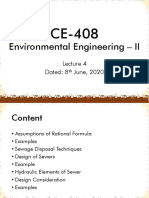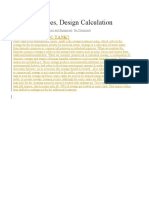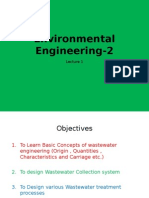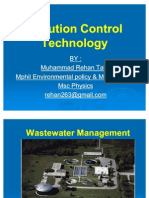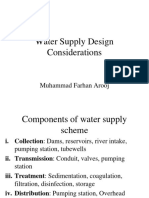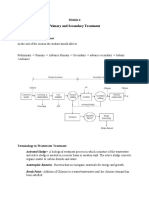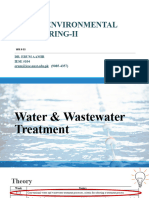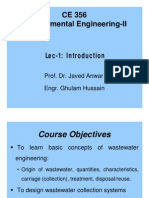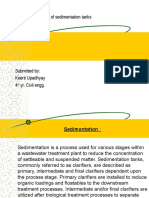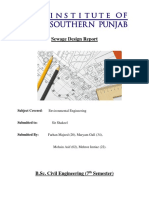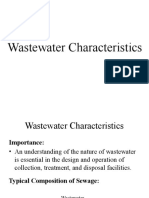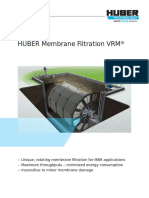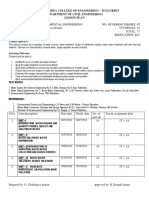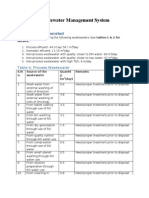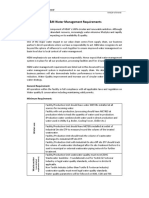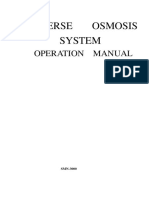0 ratings0% found this document useful (0 votes)
25 viewsEnvironmental Engineering 2
Environmental Engineering 2
Uploaded by
Sajjad HussainThis document discusses key concepts related to sewerage systems and wastewater treatment. It defines different types of sewers and outlines the typical hierarchy from house connections to main sewers. It also discusses the factors considered in preliminary investigations for sewerage system design such as population density, soil characteristics, and rainfall data. The document also provides an overview of wastewater treatment processes from preliminary to tertiary treatment and defines various treatment unit operations.
Copyright:
© All Rights Reserved
Available Formats
Download as PDF, TXT or read online from Scribd
Environmental Engineering 2
Environmental Engineering 2
Uploaded by
Sajjad Hussain0 ratings0% found this document useful (0 votes)
25 views6 pagesThis document discusses key concepts related to sewerage systems and wastewater treatment. It defines different types of sewers and outlines the typical hierarchy from house connections to main sewers. It also discusses the factors considered in preliminary investigations for sewerage system design such as population density, soil characteristics, and rainfall data. The document also provides an overview of wastewater treatment processes from preliminary to tertiary treatment and defines various treatment unit operations.
Original Description:
Research principles
Copyright
© © All Rights Reserved
Available Formats
PDF, TXT or read online from Scribd
Share this document
Did you find this document useful?
Is this content inappropriate?
This document discusses key concepts related to sewerage systems and wastewater treatment. It defines different types of sewers and outlines the typical hierarchy from house connections to main sewers. It also discusses the factors considered in preliminary investigations for sewerage system design such as population density, soil characteristics, and rainfall data. The document also provides an overview of wastewater treatment processes from preliminary to tertiary treatment and defines various treatment unit operations.
Copyright:
© All Rights Reserved
Available Formats
Download as PDF, TXT or read online from Scribd
Download as pdf or txt
0 ratings0% found this document useful (0 votes)
25 views6 pagesEnvironmental Engineering 2
Environmental Engineering 2
Uploaded by
Sajjad HussainThis document discusses key concepts related to sewerage systems and wastewater treatment. It defines different types of sewers and outlines the typical hierarchy from house connections to main sewers. It also discusses the factors considered in preliminary investigations for sewerage system design such as population density, soil characteristics, and rainfall data. The document also provides an overview of wastewater treatment processes from preliminary to tertiary treatment and defines various treatment unit operations.
Copyright:
© All Rights Reserved
Available Formats
Download as PDF, TXT or read online from Scribd
Download as pdf or txt
You are on page 1of 6
Sewage: Water; Sewer: Pipe; Sewerage: System
Types of Sewers based on Sewage: Sanitary, storm, combined.
Sewers Hierarchy: house sewer, lateral sewer, sub-mains, main/trunk, outfall
Separate System: Immediate need for collection of sanitary sewage but no
immediate need for storm sewage or sanitary sewage alone needs treatment.
Combined System: Mixed sewage could be disposed without treatment, both
needs treatment or less space is available.
Partially Combined: A part of storm sewage is allowed with sanitary for the
purpose of economy.
Sanitary sewage could not be disposed without treatment. Little quantity of it is
allowed with storm sewer and it remains at bottom due to high density.
Infiltrated Sewage: Entered in sewers due to poor joints or cracked pipes. More
prominent in rainy season.
WASA Lhr use infiltration for DSN: 5 % for d<600mm and 10 % d>600mm.
Inflow: Water that enters sewer through manhole covers, roof drains etc.
Sewage is 70-90% of water consumption. When infiltration %age is considered
then sewage is equal to water consumption.
14
Herman’s Formula for Peaking Factor: M = 1 +
4+ P
Where P= population in 1000s
WASA takes Peaking Factor: 2 for flow > 500,000 m3/day & 4 for <2500 m3/day.
Minimum Rate of Sewage Flow = 50 % of average sewage flow
Components of Sewerage System are designed for maximum flow but the low
flow velocities are check for minimum flows.
Pumping station is designed for 10 years and sewage treatment plant is designed
for 15-20 years.
Steps in Design: Preliminary investigation, design criteria considerations, actual
design, drawing & BOQ and Subsequent modifications.
Things to Consider in Preliminary Investigation: Population density, water
consumption, soil characteristics, natural slope, disposal points, GWT, Rainfall
data, other systems pipes.
Infiltration is considered in finding Qdesign.
WASA takes storm flow equal to peak sewage flow.
So Qdesign = 2 X Peak flow + infiltration
Hydraulic Radius is R/4 for circular and Manning’s co-efficient is 0.013-0.015.
Minimum Self-Cleansing Velocity: Minimum velocity to prevent settlement of
suspended matter. 0.6 for sanitary, 1 for combined and 0.7 for
partially-combined.
Maximum Velocity: 2.4 to avoid sewer abrasion.
Minimum Sewer Size According to WASA: 225 mm for lateral.
Minimum Cover: 1 m earth cover on sewer crown to avoid damage from live
loads.
Manhole Purpose: Cleaning, inspection, house connection.
Manhole Provision: Change in sewer direction, diameter and slope. 1 for 2-4
houses. Spacing not more than 100 m for small pipes and not more than 150 m
for larger pipes.
Qd to Qfull Ratio: Important to provide air space. < 0.7 for small and < 0.8 for
larger sewers.
Area is determined from Discharge equation and slope is determined from
Manning’s equation.
Drawings include type and size of joints, dimensions and depth of manhole and
location of disposal stations and profiles etc.
Invert Level: Lowest inside level in a sewer. Used for calculating slopes (to
make sure of self-cleansing velocities).
Upper End Invert Level = NSL - Earth cover - thickness - diameter
Lower End Invert Level = Upper Invert Level - Fall
Fall = Gradient X distance
For fall of 0.3 m in 24 m distance: Gradient is 0.0125 or 1:80 or 1 in 80.
When two or more sewers of same diameter discharge in sewer of same diameter
then lowest D/S invert level is taken as U/S invert level of receiving sewer.
When two or more sewers discharge in sewer of different diameter then crown
(inside top) is taken at same level and U/S invert level of main sewer is lowered
by diameter difference from minimum D/S invert level of discharging sewers.
Storm Sewer = C I A
Where: C = co-efficient depending on surface storage, infiltration and
evaporation; I = Rainfall intensity (depth/time); A = Tributary Area
C varies; increases as rainfall continues.
t 0.3t
C= for impervious and C = for pervious
8+t 20 + t
C ranges from 0.05 to 0.3 for unpaved surfaces and soils and it is 0.7 to 0.9 for
paved surfaces.
Inlet Time: Time required for rain water to flow from farthest point over the
surface to sewer inlet.
Concentration Time: Time required for maximum runoff rate to develop
Time of concentration = Inlet time + time of flow
Critical Duration of Rainfall = Duration of Rainfall producing maximum runoff
= Time of Concentration
V V
Cycle Time = Running time + time of filling = +
P -Q Q
For Minimum Cycle Time: Sewage Flow Rate (Q) = Half of Pumping Rate (P)
tmin = 4V/P
Nature of sewage is important for design and operation of collection, treatment
and disposal facilities.
Solids in Waste-water: 0.1 % solids are present which include:
Total solids: (all matter that remain residue while boiling at 103-105 0C
Suspended: (retained on 1.2 micrometer filter paper), volatile (organic), fixed
(inorganic).
Dissolved: (passed from 1.2 micrometer filter)
Settle-able: (settle at bottom of cone in 60 minutes, also give quantity of sludge)
Temperature: Waste’s temperature is slightly greater than water supply.
Optimum temperature for bacteria is 25-30 0C.
Color: Wastewater has light brownish-gray color. By anaerobic activities color
changes to black (called septic).
Odor: Produced by decomposition of gases etc. Most common odor is that of
Hydrogen sulphide.
Alkalinity: Bicarbonates of calcium and magnesium. It helps to resist pH.
Nitrogen: Include organic nitrogen, ammonia nitrogen, nitrite and nitrate. To
control algal growth in receiving water removal of N in wastewater is needed.
Sulphates: Are converted to sulphide under anaerobic conditions which combine
with hydrogent to form hydrogen sulphide. H2S is oxidized to H2SO4 biologically
and cause corrosion of sewers.
Dissolved Oxygen: Is necessary to avoid anaerobic conditions.
Organic Matter: Measured in terms of:
Biological Oxygen Demand (BOD): Oxygen required by bacteria to oxidize
organic matter to stable end products. BOD5 at 200 C is important.
Lt = L0 e - kt
BOD Consumed (y) = L0 (1-e-kt)
K for domestic water at 200 C is 0.23 per day and Kt = K0 (1.047)T-20
Chemical Oxygen Demand (COD): Oxygen required by bacteria to oxidize
organic matter chemically using strong oxidizing agent (K2Cr2O7) in an acidic
medium (H2SO4).
COD is higher than BOD. COD is determined in only 2 hours.
COD/BOD indicates extent of biodegradability of wastewater.
Total Organic Carbon (TOC): Total amount of carbon present.
Bacteria: 0.5 to 5 Millions Bacteria per ml of water. Important when treated
wastewater is used for irrigation.
Population Equivalent: No. Of persons producing same BOD as industrial
establishment. 80-90 g BOD/person.
BOD Load = (Q * BOD) / 1000
Kg/d = m3/d * mg/L * L/m3
Wastewater Treatment: The processing of wastewater to remove pollutants to
such a quantity that is not harmful to human health (pathogens, heavy metals and
other toxic compounds) and environment (oxygen depletion, harm to aquatic life,
soil pollution and changing characteristic of water like color, turbidity).
Treated wastewater can be used for industry, irrigation and GW recharge.
Pak EPA effluent standard: BOD < 80 mg / L
Wastewater treatments are:
Preliminary: Removal of large floating particles and and grit (heavy inorganic
particles) which interfere with mechanical instruments. Include screens and grit
chamber.
Primary: Removal of suspended (settle-able) organic matter. Primary
sedimentation tank is an example. BOD removal 15-30 % and S.S removal
30-60 %.
Secondary: Removal of soluble or colloidal matter. Generally is biological
treatment like ASP, Trickling filters, Aerated lagoons and waste stabilization
pound. BOD removal 75-95 % S.S removal 90 %.
Tertiary: Trace organic materials.
Screens: Removes large suspended solids. Bar screen is coarse (2-4 inch) to fine
(0.75-2 inch). Screens are 1.5 * 10-5 m3/m3 of waste. Screens are disposed by
landfill or incineration.
Comminutor: Used in some plants to reduce particle size. That reduced size is
removed in subsequent treatment.
Grit Chamber: Remove grit (sand, clay, egg shell and metal fragments) which
may damage the pumps etc or cause trouble in primary and secondary treatment
by clogging the sludge lines etc.
Designed on the basis of separating organic and inorganic particles based on their
specific gravity. Removes particles larger than 0.2 mm. Detention time in grit
chamber is 40-60 seconds.
Primary Sedimentation Tank: Remove most of settle-able solids or 40-70 % of
suspended solids. 60-80 % of BOD is contributed by suspended and colloidal
matter so primary treatment remove only 30-45 % of BOD.
Sludge (settling particles) are removed from bottom where skimming (floating
matter) is removed from the surface.
Clarified liquor (primary effluent) is discharged over tank’s weir.
Detention Time & Flow Through Time: Theoretical time for which a particle
stays in tank (V / Q) is called detention time where actual time taken by fluid to
pass through tank (determined by tracer studies using NaCl) is called flow
through time.
Inlet Zone: Provide smooth transition from influent flow to distribute it
uniformly across inlet of tank. Generally include baffles.
Outlet Zone: Smooth transition from sedimentation zone to outlet. Weirs control
overflow rate and prevent solids from rising and leaving the the tank before they
settle.
SOR = Vs = Q / A: Critical design parameter. Independent of depth an detention
time.
Detention time of sedimentation tank is 2-8 hours.
Secondary Treatment: Biodegarting of organic matter into non-polluting
end-products. Main purpose is removing BOD.
Aerobic: More sludge, stable effluent.
Anaerobic: Less sludge, odour due to H2S.
Suspended Growth: Activated sludge process & Aerated lagoons. Treatment is
done by keeping bacteria in suspension.
Attached Growth: Microbial layer grown on surface and wastewater is sprayed
on it. Also called fix film reactors. Trickling filter is an example.
Activated Sludge: Heterogeneous microbial culture composed of
microorganisms produced in raw or settled sewage by growth of these organisms.
Bacteria present in it metabolize organic matter into CO2 and NH3 etc. Mixer of
this and sewage is called mixed liquor.
Sludge Volume Index = (Settled sludge volume * 1000) / (Mixed liquor
suspended solids). Value of 50-150 means good settling characteristics.
Sludge Buckling: Excessive carryover of flocs resulting inefficient operation of
secondary clarifier.
Growth of Filamentous Microorganisms: Insufficient operation, lack of
nutrients, presence of toxic compounds, low pH and over loading.
F:M Ratio: Food to microorganism ratio is most important design criteria.
Controls rate of oxidation and mass of organisms. It is kg of BOD per day per kg
of MLSS. Usually 0.25-0.5 F:M ratio is kept.
Aeration time for ASP is 4-8 hours.
Types of aeration processes are conventional, tapered, step, mixed, extended and
high rate aeration processes.
Operational Control of ASP includes DO, MLSS, F:M, SVI, return sludge etc.
Advantages are high BOD removal, less land area, odor free operation and
treating industrial waste well.
Disadvantages are sensitivity, skilled required, sludge buckling problem and high
operating costs.
Aerated Lagoons: Earthen basins in which wastewater is treated on flow through
basis. Low MLSS concentration and long concentration time compared with
ASP.
Partially Mixed (Facultative) Lagoons: Aeration only to fulfill oxygen demand.
Sludge decomposes anaerobically.
Fully Mixed (Aerobic) Lagoons: Aeration for BOD and solids suspension.
Detention time is 4-7 days. L = L0 / (1 + Kt); K2 = K1 (1.047)T2-T1; K = 0.5-1.5
Advantages: Less area than WSP, low capital cost, easy to operate, no skilled
labor, less odour problem and no mechanical equipment.
Disadvantages: Poor fecal coliform removal than WSP, need final clarifier and
sludge handling problem.
Trickling Filter: Bed of highly permeable material on which microorganisms
grow and and wastewater is percolated or trickled. As water percolates,
microorganisms remove the organic matter. This is an attached growth biological
treatment method.
Nutrients and organic matter is transferred to fixed layer and to bacteria and
waste products are transferred to moving water layer by diffusion. This is
collected by under-drainage system and treated in secondary treatment.
A portion of wastewater collected in the under-drainage system is recycled to
dilute influent and reduce odor problem.
Trickling filters are classified as standard, low rate and high rate filters.
Advantages: Satisfactory BOD removal, good for shock loads and low operating
cost.
Disadvantages: Head loss (3-5 m), experts required, less parts are available
locally, high construction cost and odor and fly problem.
Waste Stabilization Pounds: Shallow man-made basins into which waste water
flows and after detention time of several days a well treated effluent is
discharged.
Types of WSP: Anaerobic & facultative (for BOD removal) and maturation (for
pathogens removal)
Maturation ponds are used when treated wastewater is to be used for unrestricted
irrigation.
Restricted Irrigation: Includes industrial crops like cotton and sunflower and
food crops not for direct human use.
Unrestricted Crops: Vegetables etc.
Anaerobic Pounds: Such high organic loading (>100 g BOD / m3.day) that they
contain no DO and no algae. BOD and SS removal is 40-70 %. Retention time is
small 1-5 days. Have odour problem. BOD removal is done by sedimentation of
settle-able solids and subsequent anaerobic digestion. Works well in warm
climates. Designed on volumetric BOD loading (Lamda = L * Q /V = 100-400).
Facultative Pounds: Have 7-20 days retention time and designed relatively low
surface loading rate (100-400 Kg BOD / ha. Day). Oxygen is provided by algal
growth. Primary Type receive raw sewerage whereas Secondary Type receive
settled wastewater from anaerobic pounds.
Bacteria-Algae Symbiosis: Mutual relation of pond bacteria and pond algae in
secondary facultative pond. DO has varying concentrations throughout a day due
to photosynthesis. Facultative ponds are designed on the basis of surface BOD
loading .
Pathogens removal in maturation ponds occurs by adsorption onto settle-able
solids including algae and subsequent sedimentation. Parasites are removed by
sedimentation and consequently removal takes place in anaerobic and facultative
ponds.
Advantages: Simplicity, low operating cost, local availability of material, no
electrical energy used, no problem of flies and odour and high efficiency. Good
for developing countries like Pakistan.
Disadvantages: Large land area needed & Variable capital cost depending upon
land cost.
You might also like
- 120 KLD STP Gad LayoutDocument1 page120 KLD STP Gad LayoutTech MongerNo ratings yet
- 00 - AVANTech Capabilities & Experience - NUCLEAR (No Attachments) 11-2018Document12 pages00 - AVANTech Capabilities & Experience - NUCLEAR (No Attachments) 11-2018Laura StoutNo ratings yet
- Wastewater TreatmentDocument49 pagesWastewater TreatmentAshwani Kumar Pati TripathiNo ratings yet
- Introduction CE 408 - Environ - IIDocument14 pagesIntroduction CE 408 - Environ - IIductilityNo ratings yet
- 2 Wastewater TreatmentDocument60 pages2 Wastewater TreatmentAnkita SinhaNo ratings yet
- Sewage and SewerDocument46 pagesSewage and SewerRexNo ratings yet
- Ce 408Document30 pagesCe 408Liaqat ZaibNo ratings yet
- 2011 Design of Sewer NetworksDocument27 pages2011 Design of Sewer NetworksKwaku frimpongNo ratings yet
- EN8592 UNIT 2 Grey Water HarvestingDocument14 pagesEN8592 UNIT 2 Grey Water Harvesting2CIVIL3045 SONIYA ANo ratings yet
- Module - 1 IntroductionDocument33 pagesModule - 1 IntroductionIffat SiddiqueNo ratings yet
- Design of SewersDocument22 pagesDesign of SewersArshdeep AshuNo ratings yet
- 2018 Waste Water Collection Systems - EugeneDocument51 pages2018 Waste Water Collection Systems - EugeneKwaku frimpongNo ratings yet
- Astewater Reatment Lant DesignDocument2 pagesAstewater Reatment Lant Designas3ateNo ratings yet
- EE Notes FULLDocument56 pagesEE Notes FULLAnonymous Q4MsQANo ratings yet
- EEDM Notes Unit-3Document30 pagesEEDM Notes Unit-3sunilkahar2021No ratings yet
- Water Supply and Environmental Engineering: Chapter - 2 Preliminary TreatmentDocument63 pagesWater Supply and Environmental Engineering: Chapter - 2 Preliminary TreatmentRefisa Jiru100% (1)
- Design of Septic Tank - Types, Design CalculationDocument6 pagesDesign of Septic Tank - Types, Design CalculationFarman Ali KhaskheliNo ratings yet
- Muncipal MIWWE 2Document13 pagesMuncipal MIWWE 2KajalNo ratings yet
- Septic Tank - Types, Design CalculationDocument6 pagesSeptic Tank - Types, Design Calculationzafar.ucNo ratings yet
- Ch5 WastewaterDocument33 pagesCh5 Wastewatersertsemariammamushet2No ratings yet
- Lec 1 (Wastewater Collection System)Document29 pagesLec 1 (Wastewater Collection System)Haris MahmoodNo ratings yet
- Group 14 - WastewaterDocument18 pagesGroup 14 - WastewaterMemphis EmmaNo ratings yet
- Cep ReportDocument29 pagesCep ReportAli AhmadNo ratings yet
- Hydraulic Design of Sewer PipesDocument34 pagesHydraulic Design of Sewer PipesAkhil Shetty100% (3)
- 3 Sewage and Sewer DesignDocument25 pages3 Sewage and Sewer DesignMuhammad AmirNo ratings yet
- 6-Screens and Grit ChambersDocument18 pages6-Screens and Grit ChambersMuhammad AmirNo ratings yet
- ASP - PPT - EE-TTDocument31 pagesASP - PPT - EE-TTRitesh KumarNo ratings yet
- Sewage Treatment (Wsst4026)Document140 pagesSewage Treatment (Wsst4026)tarewatersNo ratings yet
- Wastewater Treatment: Physical and Chemical Process: Basic ConceptsDocument49 pagesWastewater Treatment: Physical and Chemical Process: Basic ConceptsVIRGILIO MANANGANNo ratings yet
- Environmental Engg 2 Lecture 1Document24 pagesEnvironmental Engg 2 Lecture 1Thiru VenkadamNo ratings yet
- 4.introduction To The Design and Process Calculations (542089)Document35 pages4.introduction To The Design and Process Calculations (542089)ahmed salam100% (1)
- CH 4 1Document28 pagesCH 4 1Abdanur JihadNo ratings yet
- PCT Pollution Control Technology (M REHAN TAHIR) - Waste Water TreatmentDocument71 pagesPCT Pollution Control Technology (M REHAN TAHIR) - Waste Water Treatmentrehan263No ratings yet
- Ws Design CourseDocument70 pagesWs Design Coursesayed samiullahNo ratings yet
- M24L40Document7 pagesM24L40Andenet AshagrieNo ratings yet
- Sewrage DesignDocument13 pagesSewrage DesignRajendra Badjatya100% (1)
- Evs Micro ProjectDocument10 pagesEvs Micro Projectmoreanushka34No ratings yet
- Environmental AssignmentDocument12 pagesEnvironmental AssignmentBurhan ZaheerNo ratings yet
- Water PollutionDocument40 pagesWater PollutionSurendra ReddyNo ratings yet
- Chapter - 4 INTRODUCTION TO WATER TREATMENTDocument16 pagesChapter - 4 INTRODUCTION TO WATER TREATMENTdawana samuelNo ratings yet
- 6 3 Sewage and Sewer DesignDocument13 pages6 3 Sewage and Sewer DesignYeshihareg AlemuNo ratings yet
- Water Supply Design ConsiderationsDocument56 pagesWater Supply Design ConsiderationsSarim ChNo ratings yet
- Project Report: Small Sewage Treatment PlantDocument58 pagesProject Report: Small Sewage Treatment PlantAnurag Dixit100% (1)
- Chapter-4 Sewarage SystemDocument65 pagesChapter-4 Sewarage SystemGebrewahid AdhanaNo ratings yet
- Onsite Sanitation: Architecture GATE SolutionDocument6 pagesOnsite Sanitation: Architecture GATE SolutionPratik ManeNo ratings yet
- Wastewater EnggDocument39 pagesWastewater EnggfawazNo ratings yet
- Trickling Filters PDFDocument16 pagesTrickling Filters PDFJohnclaude ChamandiNo ratings yet
- Design of Sewage Treatment PlantsDocument72 pagesDesign of Sewage Treatment PlantsKaranam Vamsi Ranga RaoNo ratings yet
- Sewage Treatment Plants and DesignDocument72 pagesSewage Treatment Plants and Designsatishkumarkolluru9809100% (2)
- Primary and Secondary TreatmentDocument8 pagesPrimary and Secondary TreatmentJohn Rhey Almojallas BenedictoNo ratings yet
- WK 03-Wastewater Treatment CriteriaDocument24 pagesWK 03-Wastewater Treatment CriteriaTalha MustafaNo ratings yet
- SewerDocument32 pagesSewerharshittholiyabikanerNo ratings yet
- 1 PDFDocument23 pages1 PDFAsad Jalil100% (1)
- Case Study - Water Supply 2009Document133 pagesCase Study - Water Supply 2009TS WongNo ratings yet
- This One TooDocument28 pagesThis One TooNobodyNo ratings yet
- Sewage Sections-EeDocument64 pagesSewage Sections-Eegautam dasNo ratings yet
- Design Fundamentals of Sedimentation Tanks KeertiDocument26 pagesDesign Fundamentals of Sedimentation Tanks KeertiMesfin DerbewNo ratings yet
- Sewage Treatment Plant Design ProjectDocument30 pagesSewage Treatment Plant Design Projectgk mNo ratings yet
- Lecture 12 FiltrationDocument28 pagesLecture 12 FiltrationpiumalkumarasingheNo ratings yet
- Wastewater Conveyance SystemDocument24 pagesWastewater Conveyance SystemShahid Niaz Apu 200051258No ratings yet
- Sewage Design ReportDocument6 pagesSewage Design ReportMehroz Imtiaz100% (5)
- Economic Update 22-24Document17 pagesEconomic Update 22-24Sajjad HussainNo ratings yet
- Assistant Director (Technical) (Bs-17)Document1 pageAssistant Director (Technical) (Bs-17)Sajjad HussainNo ratings yet
- Rawalpindi Bus Stand - DesigbDocument1 pageRawalpindi Bus Stand - DesigbSajjad HussainNo ratings yet
- 01 FIDIC Yellow Silver Books 201200613Document96 pages01 FIDIC Yellow Silver Books 201200613Sajjad Hussain100% (1)
- Research 03Document1 pageResearch 03Sajjad HussainNo ratings yet
- HVAC Water TreatmentDocument6 pagesHVAC Water TreatmentAbdullah.N FAAliNo ratings yet
- The Effectiveness of Musa Acuminata Colla Banana Peels As Purifying Agents For WaterDocument19 pagesThe Effectiveness of Musa Acuminata Colla Banana Peels As Purifying Agents For WaterVanessa FloresNo ratings yet
- Catalogo HydronixDocument68 pagesCatalogo HydronixNANCHO77No ratings yet
- Mini Project Report: Design of A Small Sewage Treatment Plant Unit For A Residetial SocietyDocument12 pagesMini Project Report: Design of A Small Sewage Treatment Plant Unit For A Residetial SocietyrahulprajapNo ratings yet
- Lec 8 (Wastewater Characteristics)Document29 pagesLec 8 (Wastewater Characteristics)MiansyedNawabNo ratings yet
- "Company Profile": Fluid Technology International (PVT) LTDDocument8 pages"Company Profile": Fluid Technology International (PVT) LTDZain Ali KidwaiNo ratings yet
- Biocidas BASFDocument11 pagesBiocidas BASFMiller MoraisNo ratings yet
- Efficiency Assessment of Combined Treatment TechnoDocument9 pagesEfficiency Assessment of Combined Treatment TechnoankitaNo ratings yet
- Duracable CatalogDocument68 pagesDuracable CatalogCleaner MagazineNo ratings yet
- A Seminar Report ON Use of Etp and STP in Wastewater TreatmentDocument21 pagesA Seminar Report ON Use of Etp and STP in Wastewater TreatmentJeevan HariyappaNo ratings yet
- 60kld ZLD Flow Diagram-10.11.18-ModelDocument1 page60kld ZLD Flow Diagram-10.11.18-ModelkezaihrajNo ratings yet
- Grundfosliterature 5236005Document3 pagesGrundfosliterature 5236005Adson Santos Silva Jr.No ratings yet
- Septic Vault Plan: National Housing AuthorityDocument1 pageSeptic Vault Plan: National Housing AuthorityDJNo ratings yet
- Septic Tank Maintenance: Advice and GuidanceDocument4 pagesSeptic Tank Maintenance: Advice and GuidanceAini ZahraNo ratings yet
- HUBER Membrane Filtration VRM®Document4 pagesHUBER Membrane Filtration VRM®AhmedRamadanNo ratings yet
- Advert For Quality Control Officer - March 2022Document3 pagesAdvert For Quality Control Officer - March 2022Reagan Mulumba0% (1)
- Wsec 2017 Fs 022 Liquid Stream Fundamentals Clarification Sedimentation FinalDocument10 pagesWsec 2017 Fs 022 Liquid Stream Fundamentals Clarification Sedimentation FinalsallyNo ratings yet
- GCKR Ee - 1 Gokula Krishna College of EngineeringDocument6 pagesGCKR Ee - 1 Gokula Krishna College of Engineeringprudviraj chouhan chemalamudiNo ratings yet
- Brochure-Innovative FiltrexDocument16 pagesBrochure-Innovative Filtrexinnovativefiltrex74No ratings yet
- ETP For Pharma Formulation UnitDocument14 pagesETP For Pharma Formulation UnitDr. Akepati Sivarami ReddyNo ratings yet
- Muhammad Ibrahim Bin Noor Alshurdin (133419)Document3 pagesMuhammad Ibrahim Bin Noor Alshurdin (133419)Muhammad IbrahimNo ratings yet
- Brochure DE NORA TETRA ABF 650 0316Document4 pagesBrochure DE NORA TETRA ABF 650 0316Khang TrầnNo ratings yet
- Physical Water TreatmentDocument10 pagesPhysical Water TreatmentVIHIKA ENGINEERINGNo ratings yet
- Clarifier DesignDocument12 pagesClarifier DesignAbinashNo ratings yet
- Rabigh WTP & Dam ReportDocument16 pagesRabigh WTP & Dam ReportShehroz Ahmad ShoaibNo ratings yet
- 7 Water Saving Measures For Cooling TowersDocument3 pages7 Water Saving Measures For Cooling TowersRahul ChandrawarNo ratings yet
- HM Water Management RequirementsDocument5 pagesHM Water Management RequirementsHasan NudinNo ratings yet
- System ManualDocument14 pagesSystem ManualCareers SSPNo ratings yet






